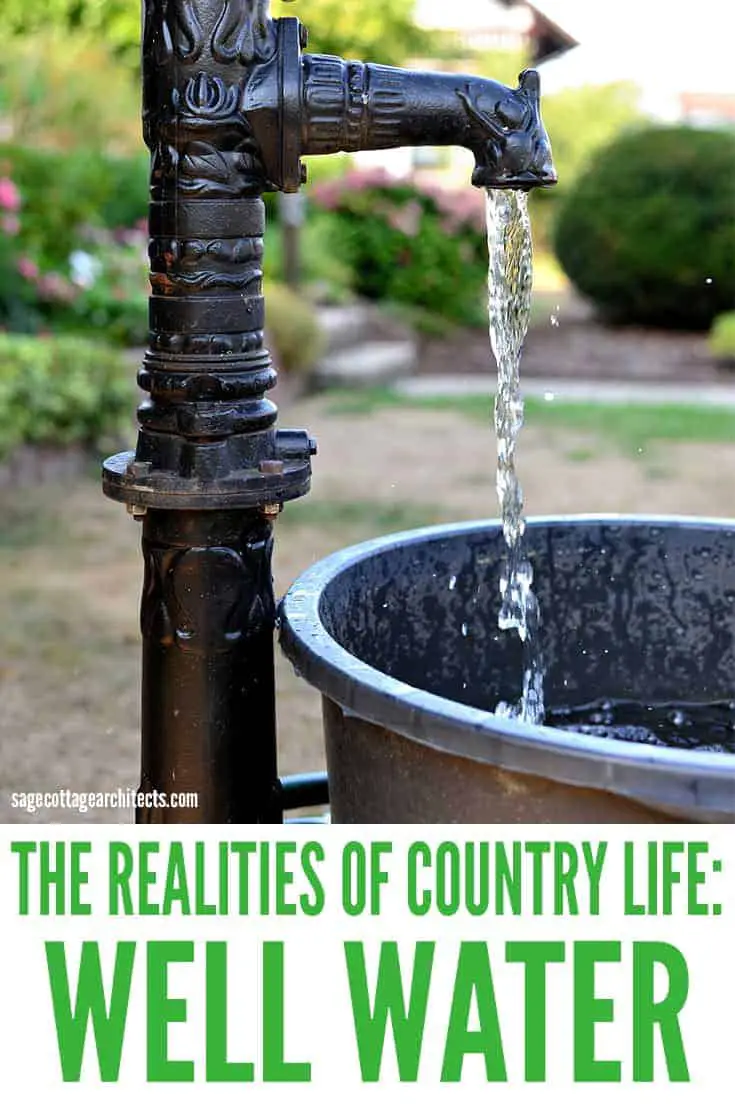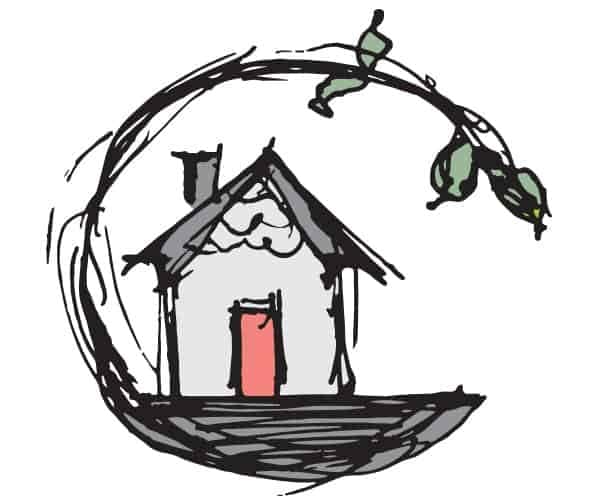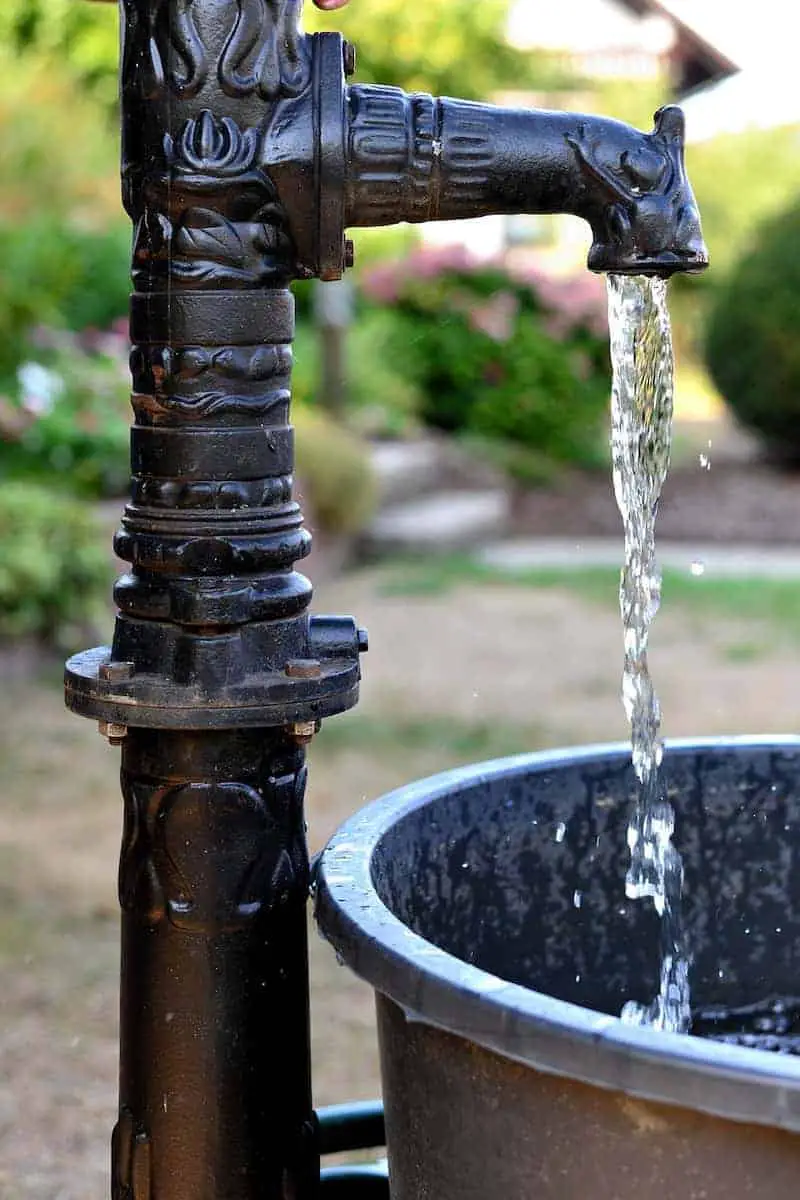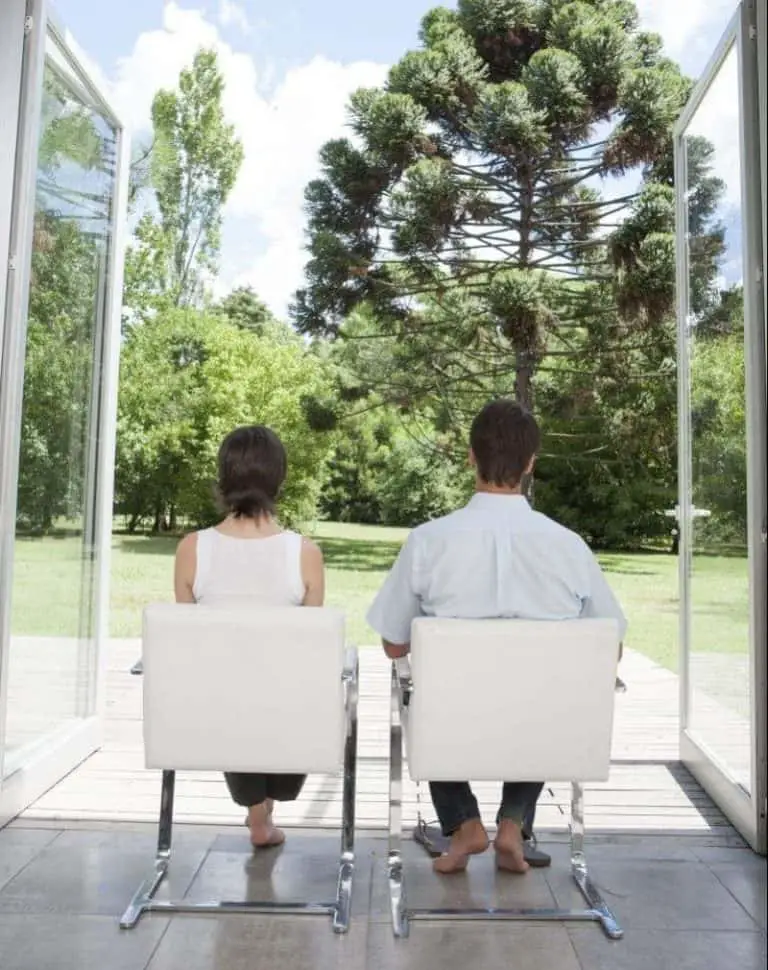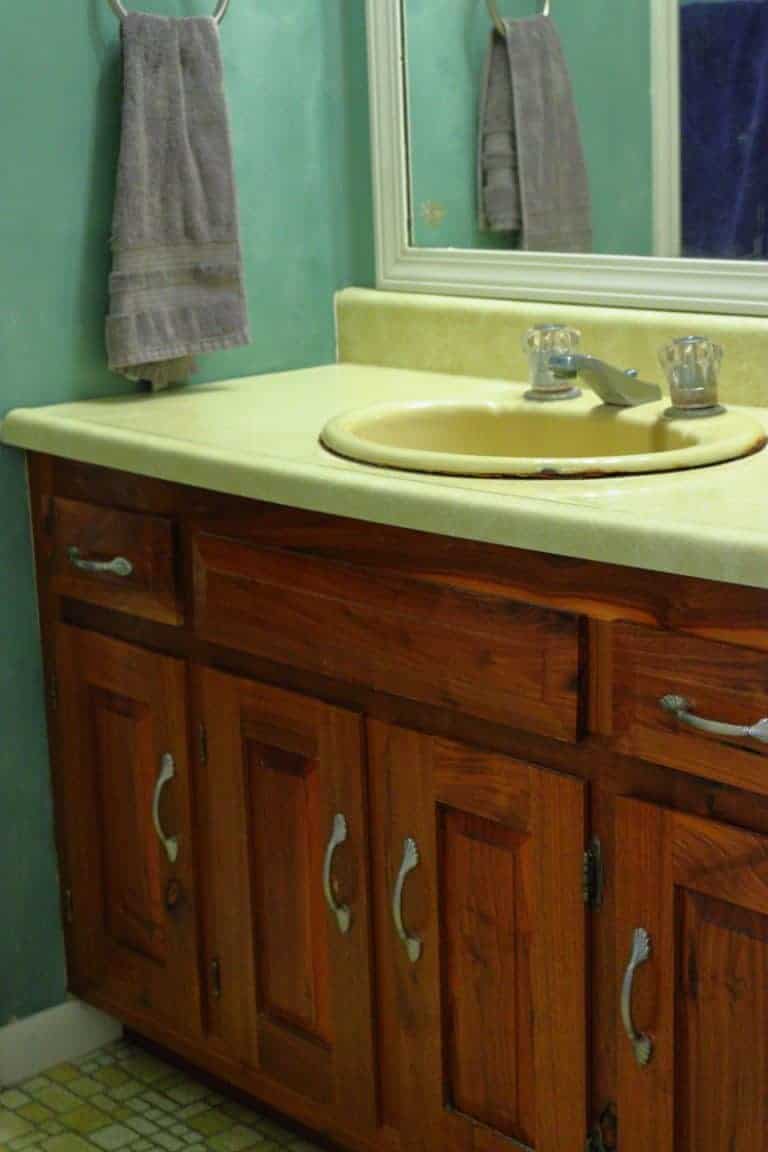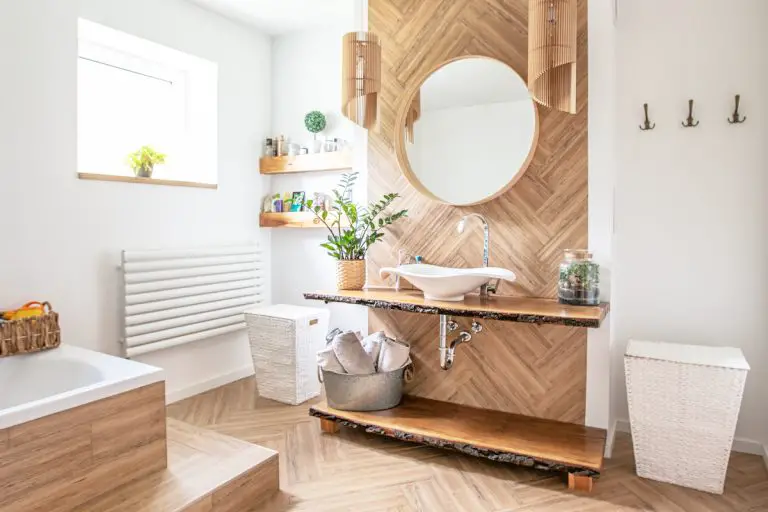Today’s post is part of my realities of country life series. I love living out in the country, but there was definitely a transition from living in cities. While I’m not Ma Ingalls headed out to pump the old well handle, living with well water is definitely different than city water.
Our house is in a rural subdivision with about fifty houses. When the neighborhood was built, the developer placed five to seven houses on each well. I’m guessing they did this to keep the initial lot costs down, but the water was pretty gross. In fact, every time Kim came to visit she told me that my water smelled funny. And it did!
The original well was not very deep – maybe 90′. The well water was hard, had a lot of iron in it, and smelled of sulfur. A few years after we replaced the septic system, we decided to leave the shared well and get our own well.
The new well is 168′ deep, and taps into the primary aquifer in the area. While the water is not perfect – it’s still hard and has some iron in it – it is so much better. My house doesn’t smell like rotten eggs anymore!
The Basics of a Well System
This diagram from the EPA shows how a well works. A hole is drilled down to the aquifer, and a well casing is installed to keep dirt and contaminants out of the well. A submersible pump at the bottom of the well pumps water up to a pressure tank inside the house. The pressure tank increases the water pressure as needed and keeps water at a constant pressure.
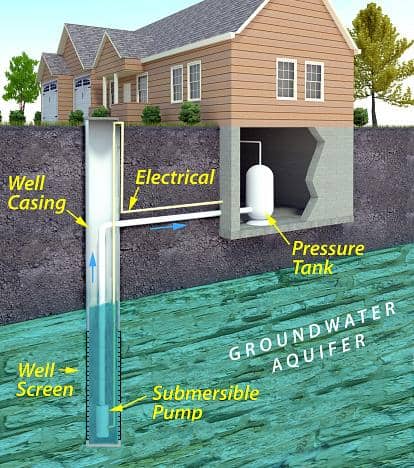
In my house, the water exits the pressure tank, goes through a filter, then the softener, and either to the hot water tank or directly to the cold water taps.
A backup generator is often a good idea when you live in the country, since a well needs electricity to pump the water. Without one, if you don’t have electricity, then you don’t have any water in the house.
Well Water Quality
In most cases, well water will need to be treated due to its high mineral content (known as hard water). Calcium and magnesium are the two common minerals that cause hard water. But untreated water can also contain iron, sulfur, arsenic, methane, tannins, iron bacteria, and sediment, just to name a few.
Hard water is not fun. It changes the effectiveness of soap and shampoo – they don’t lather normally. So you don’t feel clean after a shower. It can also leave calcium and lime buildup on everything the water touches, from showers to dishes.
Iron leaves rust stains on everything, from plumbing fixtures to the inside of washers and dishwashers. (I have found that Zud is great at removing rust stains.) Our hard water seems to be especially rough on dishwasher racks, as well.
Methane is a harmless, natural gas that will make well water sputter as it comes out of the faucet. It’s more of an annoyance than anything else. Finally, tannins can make the water look yellow or green. Not exactly what you want to see in the tub or toilet.
Water Softeners
The most common way to treat well water is with a water softener. Most softeners run water through a resin bed which is in a big, cylindrical tank. The tank is filled with salt pellets, and as water runs over the salt, the chemicals that cause hard water are removed. (If you want all the nitty gritty of ions, molecules, and the chemistry that is involved, then read this Popular Mechanics article.) Periodically, the softener system will regenerate the resin bed to clear out the hard water chemicals.
So, what does that mean to you? What do you have to do? Every 3-4 weeks, you’ll need to buy one or two 40-pound bags of water softener salt pellets. (The amount of salt and frequency of adding it all depends on your system and usage. When our system regenerated every night, and we had five people taking showers every day, we went through a lot of salt.) The salt pellets are dumped into the softener tank, and that’s about it. The system takes cares of everything else. But, you do need to keep an eye on the water quality. If the water starts to feel hard or there’s more rust than usual, then the softener probably isn’t working right.
Many water softener companies will provide a free water analysis, and explain how their system will treat the problems specific to your water. The choice of softener system really seems to vary from house to house, and well to well. I’ve talked to one neighbor with softener “X” and they love it, while another neighbor had the same system and replaced it with another brand.
If you’re planning on getting a softener from a big box store, be sure to get a home water test and select a softener that treats the specific problems of your well water. For example, some softeners only remove the hardness, and don’t remove the iron. If your water has iron in it, make sure you get a softener that removes iron. In other words, don’t grab the cheapest softener you can find. Get the right one.
Choosing A Water Softener
There are several major water softener manufacturers, each with its own pro’s and con’s. We had a Culligan system for many years (12+), and recently switched to Kinetico when the Culligan died.
We chose Kinetico for two main reasons: the softener regeneration cycle and a lack of electronics. Most softeners are set to regenerate every 24 hours – no matter how much water you used or if it’s even needed. The Kinetico system regenerates based on water usage. The more water you use, the more often it regenerates. This just seems so much smarter.
With the Culligan system, we were always having trouble with the electronic control system. Some of those problems were caused by outside factors, and not necessarily a problem with Culligan’s equipment. But, eventually it seemed like we were having to replace motherboards or other electronic parts. I wanted a system that was “stupid” and simple, not “smart” and complicated. A system that had fewer things to break. Kinetico is a non-electric system – it uses moving water to power itself. No motherboard. No blown this or blown that.
Well Water & New Construction
In most cases, a new home in the country will need a well. During the due diligence phase of buying the land, check the following in regards to a well:
- Local ordinances and requirements
- Required permits and their costs
- Known local well water problems (contaminants or hardness, for example)
- Anticipated depth of drilling
- Well water quality testing requirements
- Water softener systems and their costs (both installation and operating costs)
- Possible well locations
- Cost estimate to drill the well, including electricity, testing, and permits
While this list may seem like a lot, it probably doesn’t cover every possibility. But, you’ll need to include the costs in your budget, and it’s better to know before you start the project than to encounter unexpected problems or costs during construction.
Be sure to take well water quality and its effects on surfaces into consideration when planning bathrooms. It’s nearly impossible to keep one of those beautiful all-glass shower enclosures clean when you have hard water. Or, you can have it, but you’re going to spend a lot of time maintaining it.
Well Water & Existing Homes
If you’re looking at buying an existing home that has a well, you’ll need to get some information from the seller. A complicated looking water softener system most likely indicates water quality issues. It’s not necessarily a deal breaker, but it is something that you will be living with and that factors in to your decision to buy.
Ask the following:
- How old is the well and the well equipment?
- Location of the well? Is it shared with anyone?
- Has the well water been tested? What are the results?
- What is the well yield (in gallons per minute)? Is there sufficient water pressure?
- How old is the water softener?
- Is the softener still under warranty?
- What are the monthly operating costs for both the well and the softener?
- What are the yearly maintenance costs?
You can do a quick pressure and simple water quality test when touring the home. You don’t need to get out your lab coat and junior chemistry set, but just be aware of the water quality. Does the shower seem to have adequate pressure? Are there rust stains on the plumbing fixtures or washing machine? Does the water smell funny? Is it drinkable or does it taste terrible? That should give you a pretty good idea of the well water quality.
Whew – that got long! Living with well water isn’t difficult, it’s just different and one of the things that you have to deal with when you live in the country.
Be sure to pin this for later:
